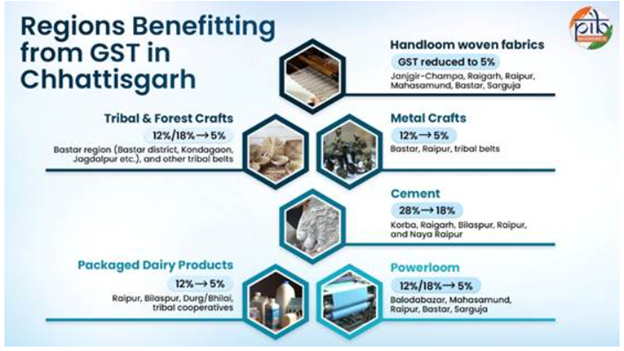“Inclusive growth is not only about industrial development, but also about empowering artisans, women, and rural communities” – Government of India
Introduction
Recent GST reforms lowering rates across handlooms, handicrafts, dairy, and cement are giving a boost to economic activity, employment, and inclusive development, aligning with the state’s vision of sustainable growth and rural empowerment.
-
- Chhattisgarh, formed in 2000 from Madhya Pradesh, is India’s 9th largest state with over 25 million residents. Chhattisgarh is known for its tribal heritage, forest resources, and industrial strength, which combines modern industry with rich artisanal traditions i.e. from Bastar’s Dhokra metal craft to Kosa and Tussar silk weaving.
Key Takeaways
-
- GST reduction to 18% lowers construction costs, drives housing demand, and sustains 20,000–30,000 jobs.
- GST cut to 5% increases demand by 10–15%, potentially creating 5,000 new jobs by 2026 and empowering women-led SHGs.
- Lower tax rates enhance competitiveness, formalization, and market access for 1.5 lakh weavers, many of whom are women.
- GST reduction from 12% to 5% stimulates demand, supports 15,000–20,000 jobs, and expands NDDB processing capacity 6x by 2028.
Sectoral Impact of GST
1. Cement Industry
-
- Concentrated in Korba, Raigarh, Bilaspur, Raipur, Naya Raipur.
- Provides ~20,000–30,000 direct and indirect jobs, including engineers, technicians, contract workers, and transporters.
- GST reduction (28% to 18%) reduces construction costs, fuels housing demand, and drives 5–10% annual employment growth in infrastructure.
2. Handloom & Powerloom Sector
-
- Districts such as Raigarh, Janjgir-Champa, Bastar employ nearly 5 lakh weavers, majority women.
- Clusters in Raigarh, Bilaspur, Janjgir-Champa supported by MSMEs; semi-skilled rural workforce, including migrants.
- GST cut to 5% improves affordability, market competitiveness, and export potential.
3. Handicrafts & Traditional Arts
-
- Bastar, Kondagaon, Jagdalpur. 50,000–60,000 artisans, mostly STs, generate ₹500–800 crore annually; GST cut from 12–18% → 5% boosts demand and supports 5,000 new jobs.
- Metal & Bell Metal Crafts- ~15,000–30,000 artisans in Dhokra, wrought iron, and bell metal crafts; ODOP promotion enhances market linkages. GST reduction lowers costs, strengthens exports, and preserves traditional skills.
4. Packaged Dairy Products
-
- 1,068, many women-led; 15,000–20,000 organized jobs
- NDDB plans 79,000 kg/day → 5 lakh kg/day by 2028, potentially creating 2,000–5,000 new jobs.
- GST cut (12% to 5%) increases consumption, strengthens cold chains, and supports women’s income in rural communities.

GST as a Driver of Inclusive Growth
-
- Reduces production costs and improves competitiveness for industrial and artisanal sectors.
- Empowers women-led rural enterprises and sustains thousands of artisan livelihoods.
- Encourages formalization and integration into national and global markets.
- Preserves tribal and traditional craftsmanship, while stimulating employment in both industrial and cottage sectors.
Way Forward
-
- Continued focus on GST-driven reforms for emerging sectors to sustain employment and exports.
- Promotion of women entrepreneurship, SHGs, and tribal craft clusters through targeted support schemes.
- Strengthening market linkages and skill development under state and central programs like PMEGP, NHDP, CHCDS, ODOP, and PM Vishwakarma Yojana.
- Leveraging digital marketplaces and e-commerce for rural and tribal artisans to expand global outreach.
Conclusion
By strengthening livelihoods, preserving traditional skills, and fostering new business opportunities, GST reforms are driving inclusive growth and positioning Chhattisgarh for sustainable socio-economic development.
Spread the Word
